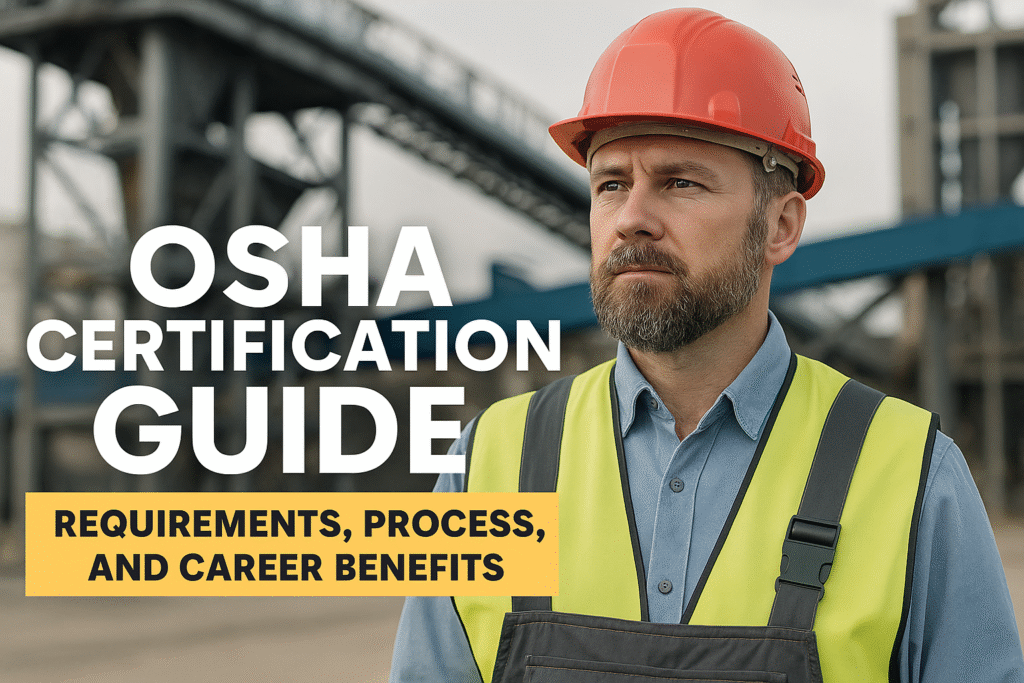
OSHA Certification Guide – Requirements, Process, and Career Benefits
Category: Certifications & Career
Focus Keyword: OSHA Certification Guide
Permalink: /osha-certification-guide
Meta Description: Learn everything about OSHA certification – eligibility, training requirements, exam process, costs, and how it boosts your career. A complete guide for professionals.
Tags: OSHA, OSHA Certification, Safety Certification, Workplace Safety, Safety Officer Career, Safety Training, Health and Safety.
Introduction
The OSHA Certification Guide is essential for anyone looking to enhance their workplace safety knowledge and career prospects. OSHA (Occupational Safety and Health Administration) certifications demonstrate that you understand the rules, regulations, and safety best practices needed to create a hazard-free workplace.
Whether you are a safety officer, supervisor, construction worker, or industrial employee, OSHA training ensures that you are equipped to handle workplace hazards, respond to emergencies, and comply with U.S. federal safety laws.
In this guide, we will cover:
- What OSHA certification means
- Types of OSHA training programs
- Eligibility criteria
- Step-by-step certification process
- Costs and duration
- Renewal requirements
- Career benefits of OSHA certification
1. What is OSHA Certification?
OSHA certification is proof that you have completed OSHA-approved training that focuses on occupational health and safety standards.
While OSHA itself does not issue “certificates” directly, it authorizes specific OSHA Training Institute (OTI) Education Centers and outreach trainers to provide official OSHA courses. These courses focus on:
- Hazard recognition and control
- Safety regulations and compliance
- Worker rights and employer responsibilities
2. Types of OSHA Certification Programs
There are several OSHA certification programs tailored for different industries and job roles.
2.1 OSHA 10-Hour Training
- Designed for entry-level workers.
- Covers basic safety awareness for recognizing and preventing hazards.
- Available in OSHA 10-Hour General Industry and OSHA 10-Hour Construction formats.
2.2 OSHA 30-Hour Training
- Designed for supervisors, managers, and safety officers.
- Covers a deeper understanding of safety regulations, hazard control, and reporting procedures.
- Available in OSHA 30-Hour General Industry and OSHA 30-Hour Construction formats.
2.3 OSHA Outreach Training
- Conducted by OSHA-authorized trainers.
- Flexible training structure with industry-specific modules.
2.4 Specialized OSHA Courses
- OSHA 510: Occupational Safety and Health Standards for Construction
- OSHA 511: Occupational Safety and Health Standards for General Industry
- OSHA 500 & 501: Trainer courses for those who want to teach OSHA classes
3. Who Needs OSHA Certification?
While OSHA certification is not legally mandatory for all workers, it is highly recommended or required in many industries.
You should get OSHA certified if you are:
- A construction worker or foreman
- A safety officer or safety manager
- A manufacturing plant employee
- A warehouse operator
- A maintenance technician
- Involved in oil & gas or mining operations
4. OSHA Certification Requirements
Before enrolling in an OSHA course, you should:
- Be at least 18 years old (for most OSHA programs)
- Have basic English reading and comprehension skills
- Be employed or intending to work in a field requiring safety knowledge
5. Step-by-Step Process to Get OSHA Certified
Step 1: Choose the Right Course
Decide between OSHA 10-hour, OSHA 30-hour, or a specialized OSHA course based on your job role and industry.
Step 2: Enroll with an Authorized Provider
Only enroll with OSHA-authorized training providers. You can find a list on the official OSHA website.
Step 3: Complete the Training
Attend all required sessions — either in-person or online.
- OSHA 10: Takes about 2 days
- OSHA 30: Takes about 4 days
Step 4: Pass the Assessment
Some courses have quizzes or final assessments to ensure you understand the material.
Step 5: Receive Your OSHA Card
Once you complete the course, you will receive an official OSHA wallet card (valid for life in most cases, though updates may be required if regulations change).
6. OSHA Certification Costs
The cost varies depending on the training provider and format:
- OSHA 10-Hour: $60 – $150
- OSHA 30-Hour: $150 – $300
- Specialized OSHA Courses: $400 – $1,000+
7. OSHA Certification Validity & Renewal
- OSHA 10 and 30 cards do not expire under federal law.
- However, some states, employers, or unions require renewal every 3–5 years.
- It’s recommended to take refresher training to stay updated with the latest safety laws.
8. Career Benefits of OSHA Certification
Getting OSHA certified offers multiple advantages:
8.1 Enhanced Job Opportunities
Employers prefer candidates with OSHA training because it shows commitment to safety.
8.2 Better Workplace Safety
Workers with OSHA certification are less likely to be involved in accidents.
8.3 Compliance with Legal Requirements
Helps companies avoid fines and legal penalties by ensuring staff are trained.
8.4 Increased Earnings
Many safety roles pay more if the employee holds OSHA certification.
9. OSHA Certification for International Professionals
Even if you work outside the U.S., OSHA certification is respected worldwide.
Many multinational companies require OSHA standards for safety compliance in:
- Construction
- Oil & Gas
- Manufacturing
- Mining
10. Common Mistakes to Avoid When Getting OSHA Certified
- Choosing an unapproved trainer – Always verify authorization.
- Not completing the entire training – You must attend all required hours.
- Ignoring specialized training – Choose courses relevant to your industry.
Conclusion
An OSHA certification is more than just a piece of paper — it’s a career investment that can open doors to better job opportunities, higher salaries, and safer workplaces.
If you are serious about your safety career, follow this OSHA Certification Guide to choose the right training, complete it successfully, and make the most of the benefits.
Internal Link:
How to Pass the IOSH Managing Safely Exam – 15 Expert Tips for Succes
Top 20 NEBOSH IGC Preparation Tips – Ace Your Exam with Confidence
How to Build a Successful Safety Officer Career – Skills, Certifications, and Growth Path
Electrical Safety Toolbox Talk – Preventing Shocks, Fires, and Accidents
Fire Safety Toolbox Talk – Prevention, Response, and Evacuation